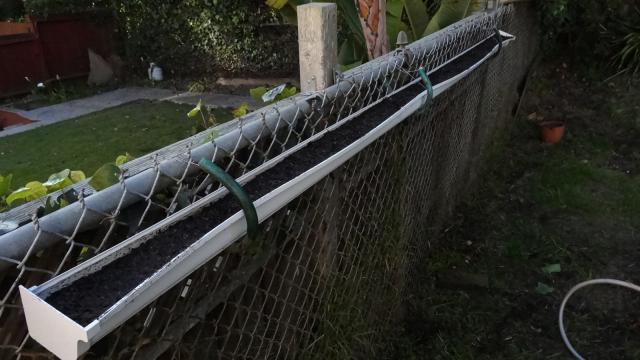City living shouldn’t preclude you from working your land — even if it’s paved over in concrete. Here’s a simple, inexpensive means of creating your own ‘Hanging Gardens of Babylon’ using a gutter and a chain-link fence.
Should You Do This?
Yes, if you have limited floor space for gardening but an abundance of walls.
Moment of Satisfaction
Making a salad out of things you found in the gutter.
Biggest Pain?
Waiting for the first sprouts to appear and validate the time and money you’ve invested in the project.
Materials and Tools Required
- 1x open-top plastic or aluminium gutter
- 2x end caps
- 55-85 litres of planting soil (preferably with compost or granular fertiliser added if you don’t already them have on-hand)
- 1x roll of heavy-duty bailing wire
- 1x 180cm length of garden hose
- Optional: 5x galvanised 38mm screws (for mounting on an exterior wall) and stud finder
- 1x bottle of waterproof sealing epoxy, clear
- 1x pair wire snips
- 1x pair heavy-duty garden shears
- 1x hand drill
- 13mm drill bit
- 1x tape measure
Difficulty and Cost
Materials should run you about $50 from your local Bunnings Warehouse store. Assembly is really easy, even if you’re assembling it solo.
Building It
Planning: Before you rush out to your local home improvement centre for supplies, pick a suitable site for the garden.
Ideally, it will be north facing, receive plenty of light over the course of a day and have proper drainage (since water from your garden will be leaking out of the gutter’s base onto the ground below). Use the tape measure to figure out how much horizontal space you have to work with and either buy or cut a length of gutter to fit.
Assemble the garden
First, ensure you’ve got the proper length of gutter and have double-checked that it both fits flush against whatever it’s being mounted to and the end caps fit securely to the gutter. Next, run a bead of sealant around both edges of the gutter and end cap where they’ll be joined, press the two pieces together, and let them cure according to the package instructions. Once set, invert the gutter (so that the bottom edge is facing up) and drill a series of drainage holes along its length, one every 200-300mm.
Hang the garden
That gutter is going to be pretty heavy once you fill it with moist soil, so you’ll want to install supports every 600mm or so. If you’re hanging it off a chain-link fence as I have, cut four or five lengths of wire long enough to encircle the gutter and leave enough material to tie off. Also cut an equal amount of 200mm lengths of garden hose. String the wire through the hose (which prevents the wire from rubbing against or cutting into the gutter), curl it into a large loop and loosely tie it to the fence. Repeat this with the other pieces of wire and rubber, and space them accordingly. Then, run the gutter through the loops to make sure every thing fits and supports properly, then tighten the wire loops until they are snug against the gutter (but no so much that they’re squishing it), firmly tie off the wire and snip off any excess.
If you plan to mount the gutter directly to a wall instead, use the stud-finder to locate suitable anchor points, then have an assistant hold the gutter in place as you sink the galvanised screws in. Be sure to seal around the screw heads to prevent water intrusion into the wall, which could lead to dry rot.
Planting
Slowly fill the gutter with your soil mix, adding equal amounts to both ends first and pushing excess/filling towards the centre. Leave about a 2.5cm of space between the soil line and the lip of the gutter. Water the soil and allow it to fully drain (take the opportunity to ensure that none of the drain holes are clogged) before sowing your crop and watering again.
Depending on the depth of your gutter, most root vegetables aside from carrots or potatoes — say, beets and radishes — will work well, as will lettuce, bush bean, celery, garlic, green onion, and common herbs, like basil and parsley. Basically, anything that doesn’t need a deep root system will grow just fine.
